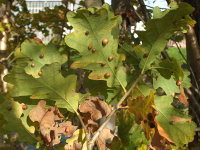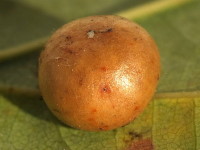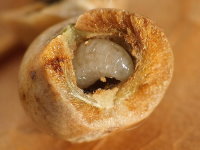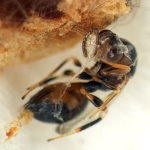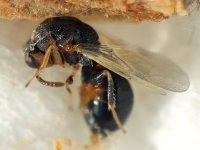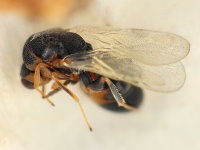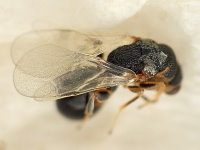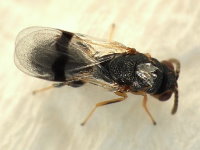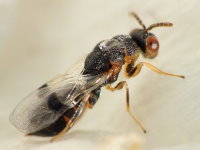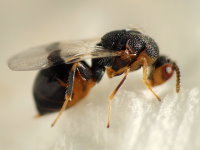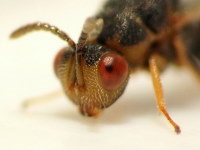An Occupant of a Plant Gall of Cynips divisa
Gall Wasps
The gall wasps (Cynipidae) are a family of Hymenoptera belonging to the suborder Apocrita. Gall wasps are usually small inconspicuous colored insects with a body length of about 1-8 mm. The larvae of gall wasps live and develop in outgrowths of plant tissue (plant galls) whose formation was induced by oviposition of the female. The larvae feed on vegetable (phytophagous). For this in many galls a special nutritive tissue is formed. After completion of larval stage pupation takes place within the protective gall. The fully developed gall wasps eat a circular hole in the surrounding tissue and leave the plant gall.
Many of gall wasps have an alternation of generations with one bisexual and one parthenogenetic generation annually. Parthenogenesis is a form of unisexual reproduction. The offspring arise from unfertilized eggs. The different generations differ in appearance and in the form of plant galls induced by them. More detailed information on gall wasps and galls can be found in [1-3].
Images of the Occupier
In early November, I have found some plant galls of the parthenogenetic generation of the Cherry Gall Wasp (Cynips quercusfolii) and of Cynips divisa. In a large friable gall of Cynips quercusfolii there was a fully developed gall wasp. Images of the Cherry Gall Wasp and their galls can be found on the species page of Cynips quercusfolii.
The round, approximately 5-6 mm sized plant galls of Cynips divisa shown in Figure 1 to 4 are less conspicuous than the 2 cm large galls of Cynips quercusfolii and usually sit on the leaf veins on the underside of oak leaves. Figure 3 shows the cross section through the gall shown in Figure 2. The larval chamber inside the gall was empty. In a second gall there was a larva (Figure 4). It had fallen out of the opened gall and was not pupated on 14/11/2014. On this day and the day before my attempts to photograph the colorless, almost white larva on a white background were unfortunately little successful due to the low contrast.
After 8 days when I looked for the larva it was pupated (Figures 5 and 6) and the already dark colored, about 3 mm long wasp was clearly to recognize through the thin transparent skin of the pupa.
On 25 November, the wasp had destroyed the puparium and tried to get rid of the remaining skin. The partially unfolded wings on Figure 7 and 8 confirm that the wasp hatched shortly before.
Half an hour later, the transparent and finely hairy wings were fully developed and could harden (Figure 9 - 11).
The next day the wings had changed color and showed prominent dark regions (Figures 12 to 14). The body coloration of the wasp had not changed. The bottom side and areas of the head and thorax have retained their lighter color and drawing (Figure 14-17). The images of the hatched wasp confirmed my suspicion arisen at the first viewing of the pupa pictures that there may be no gall wasp.
Chalcid Wasps - Family Eurytomidae - Genus Sycophila
The wasp that has evolved from the larva in the gall of Cynips divisa belongs to the Chalcidoidea [4], a superfamily of Hymenoptera, especially to the family Eurytomidae [5]. The family is a polyphyletic group, that is, in their species are summarized, which cannot be attributed to any single ancestral form. The majority of the members are either phytophagous or parasitoids of phytophagous insects. A parasitoid is an insect that lives parasitically in its development and finally kills the host.
The wasp shown here most likely belongs to the genus Sycophila.
Most of Sycophila species are, at least during a part of their larval development, insectivores (entomophages) who complete their feeding on plant tissue. Most of these species are entomophagous idiobiont ectoparasitoids of insect larvae. Idiobiont parasitoids are parasitoids where the egg-laying females paralyzes or immobilizes the host by a poison sting. Ectoparasitoids develop outside the host and eat their host from the outside.[6]
Result of the Internet Search
Detailed information on parasitoids in oak galls produced by gall wasps is available in [7].
For Germany 5 Sycophila species and beside Sycophila 4 more genera of the Eurytomidae family are currently listed in [8]: Bruchophagus, Eurytoma, Systole and Tetramesa.
The gall wasp Cynips divisa is listed on http://www.nhm.ac.uk/ as host of wasps of the genera Eurytoma and Sycophila, especially of Sycophila biguttata.
On the Internet there are some pictures of wasps of the genus Sycophila, colored either lighter or darker as the wasp shown on this page, but showing a good agreement in the physique. The wasp on this page has the same dark wing marks as Sycophila biguttata in the internet, but it is not dark colored throughout.
Summary
In the plant gall of Cynips divisa there was a wasp larva from the family Eurytomidae, which most likely belongs to the genus Sycophila. The larva of the Chalcid wasp, which normally lives in the gall, has also pupated outside. The pupal stage lasted a maximum of 10 days. The wasp hatched on 25 November and housed on the balcony was not blown away until the morning of the 8th of December and had only now and then stretched its legs. December 8 was a sunny day. The following morning the parasitoid was gone.
Thanks to Rapha1 for determining the wasp in the Hymis forum.
References and further reading:[1] Klaus Hellrigl, Pflanzengallen und Gallenkunde - Plant Galls and Cecidology, forest observer vol. 5, 2010, 207-328
[2] Fritz Schremmer, Was wissen wir von Pflanzengallen?, ÖKOL 6/3 (1984): 3-10
[3] http://de.wikipedia.org/wiki/Gallwespen
[4] http://de.wikipedia.org/wiki/Erzwespen
[5] http://www.nhm.ac.uk/research-curation/research/projects/chalcidoids/eurytomidae.html
[6] http://de.wikipedia.org/wiki/Parasitoid
[7] Richard R. Askew, George Melika, Juli Pujade-Villar, Karsten Schönrogge, Graham N. Stone & Jose Luis Nieves-Aldrey, Catalogue of parasitoids and inquilines in cynipid oak galls in the West Palaearctic, Zootaxa 3643 (1): 001-133, 2013
[8] de Jong, Y.S.D.M. (ed.) (2013) Fauna Europaea version 2.6.2 Web Service available online at http://www.faunaeur.org
